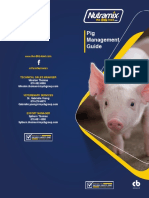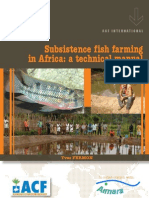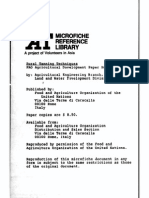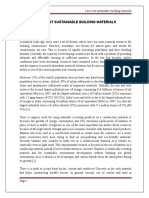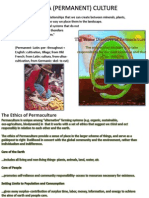0 ratings0% found this document useful (0 votes)
73 viewsWaterlogged Death - The End of Beef
Waterlogged Death - The End of Beef
Uploaded by
JeremiadusAmericans consume more meat per capita than any other nation (about 265 pounds/year). Indeed, one way to grasp our national vastness is to consider the sheer quantity of the killing that occurs every year to keep meat at the center of our food economy. Not constitutionally disposed to appreciate irony, the marketing wing of the American meat and poultry industry proudly parades the gross numbers (as it were). In 2013, with relentless, riparian efficiency, we slaughtered 32 million beef cattle, 113 million hogs, 250 million turkeys, and – astonishingly – 8.6 billion chickens.
Also without irony, American meat industry extols the low cost of food consumption in the United States – with 6.4 percent of disposable income in the U.S. spent on food compared to 10 percent in the United Kingdom, 24 percent in Mexico, and 48 percent in India. What the meat industry fails to mention is the degree to which this artificially low (and unevenly applied) cost of food masks significant and broadly ranging external costs – to the environment, to public health, to education, to labor markets, and to poverty – that endanger our national future far more than would an honest cost accounting of our food economy.
Copyright:
© All Rights Reserved
Available Formats
Download as PDF, TXT or read online from Scribd
Waterlogged Death - The End of Beef
Waterlogged Death - The End of Beef
Uploaded by
Jeremiadus0 ratings0% found this document useful (0 votes)
73 views10 pagesAmericans consume more meat per capita than any other nation (about 265 pounds/year). Indeed, one way to grasp our national vastness is to consider the sheer quantity of the killing that occurs every year to keep meat at the center of our food economy. Not constitutionally disposed to appreciate irony, the marketing wing of the American meat and poultry industry proudly parades the gross numbers (as it were). In 2013, with relentless, riparian efficiency, we slaughtered 32 million beef cattle, 113 million hogs, 250 million turkeys, and – astonishingly – 8.6 billion chickens.
Also without irony, American meat industry extols the low cost of food consumption in the United States – with 6.4 percent of disposable income in the U.S. spent on food compared to 10 percent in the United Kingdom, 24 percent in Mexico, and 48 percent in India. What the meat industry fails to mention is the degree to which this artificially low (and unevenly applied) cost of food masks significant and broadly ranging external costs – to the environment, to public health, to education, to labor markets, and to poverty – that endanger our national future far more than would an honest cost accounting of our food economy.
Original Title
Waterlogged Death.the End of Beef
Copyright
© © All Rights Reserved
Available Formats
PDF, TXT or read online from Scribd
Share this document
Did you find this document useful?
Is this content inappropriate?
Americans consume more meat per capita than any other nation (about 265 pounds/year). Indeed, one way to grasp our national vastness is to consider the sheer quantity of the killing that occurs every year to keep meat at the center of our food economy. Not constitutionally disposed to appreciate irony, the marketing wing of the American meat and poultry industry proudly parades the gross numbers (as it were). In 2013, with relentless, riparian efficiency, we slaughtered 32 million beef cattle, 113 million hogs, 250 million turkeys, and – astonishingly – 8.6 billion chickens.
Also without irony, American meat industry extols the low cost of food consumption in the United States – with 6.4 percent of disposable income in the U.S. spent on food compared to 10 percent in the United Kingdom, 24 percent in Mexico, and 48 percent in India. What the meat industry fails to mention is the degree to which this artificially low (and unevenly applied) cost of food masks significant and broadly ranging external costs – to the environment, to public health, to education, to labor markets, and to poverty – that endanger our national future far more than would an honest cost accounting of our food economy.
Copyright:
© All Rights Reserved
Available Formats
Download as PDF, TXT or read online from Scribd
Download as pdf or txt
0 ratings0% found this document useful (0 votes)
73 views10 pagesWaterlogged Death - The End of Beef
Waterlogged Death - The End of Beef
Uploaded by
JeremiadusAmericans consume more meat per capita than any other nation (about 265 pounds/year). Indeed, one way to grasp our national vastness is to consider the sheer quantity of the killing that occurs every year to keep meat at the center of our food economy. Not constitutionally disposed to appreciate irony, the marketing wing of the American meat and poultry industry proudly parades the gross numbers (as it were). In 2013, with relentless, riparian efficiency, we slaughtered 32 million beef cattle, 113 million hogs, 250 million turkeys, and – astonishingly – 8.6 billion chickens.
Also without irony, American meat industry extols the low cost of food consumption in the United States – with 6.4 percent of disposable income in the U.S. spent on food compared to 10 percent in the United Kingdom, 24 percent in Mexico, and 48 percent in India. What the meat industry fails to mention is the degree to which this artificially low (and unevenly applied) cost of food masks significant and broadly ranging external costs – to the environment, to public health, to education, to labor markets, and to poverty – that endanger our national future far more than would an honest cost accounting of our food economy.
Copyright:
© All Rights Reserved
Available Formats
Download as PDF, TXT or read online from Scribd
Download as pdf or txt
You are on page 1of 10
-1-
Waterlogged Death: The End of Beef 2014
Waterlogged Death
The End of Beef
By Peter Schwartz
Gridrevolution.co October 10, 2014
-2-
Waterlogged Death: The End of Beef 2014
mericans consume more meat per capita than any
other nation (about 265 pounds/year). Indeed, one
way to grasp our national vastness is to consider the
sheer quantity of the killing that occurs every year to keep meat
at the center of our food economy. Not constitutionally disposed
to appreciate irony, the marketing wing of the American meat
and poultry industry proudly parades the gross numbers (as it
were). In 2013, with relentless, riparian efficiency, we
slaughtered 32 million beef cattle, 113 million hogs, 250 million
turkeys, and astonishingly 8.6 billion chickens.
Also without irony, American meat industry extols the low cost
of food consumption in the United States with 6.4 percent of
disposable income in the U.S. spent on food compared to 10
percent in the United Kingdom, 24 percent in Mexico, and 48
percent in India. What the meat industry fails to mention is the
degree to which this artificially low (and unevenly applied) cost
of food masks significant and broadly ranging external costs
to the environment, to public health, to education, to labor
markets, and to poverty that endanger our national future far
more than would an honest cost accounting of our food
economy.
As the most prominent intermediary between food producers
and food consumers, McDonalds (NYSE:MCD) benefits
inordinately by keeping this chili con carnage on the down low.
Wal-Mart (NYSE:WMT) is probably equal to McDonalds as a
consumer-facing purveyor of meat. However, given its strangely
codependent relationship with meat producers and finishers
such as Cargill and Tyson (NYSE:TSN), McDonalds remains
culturally unique as the happy face of an almost unfathomably
brutal and destructive industry.
Agricultural Subsidies and the True Cost of Food
Government agricultural subsidies conceal the economic costs
and environmental impact of our patriotic allegiance to cheap
A
-3-
Waterlogged Death: The End of Beef 2014
meat, including those externalities associated with water
profligacy in a time of drought. Beyond the obvious
environmental impacts, market distortions resulting from these
subsidies most of which ultimately support crop production for
animal feed include monoculture, industrial farming,
immiseration of peasant farmers in developing countries,
subsistence wages for American workers, and the nutrition and
health consequences of artificially low prices for energy-
dense (high-calorie) food. Estimated costs of these distortions
exceed $400 billion annually. Someone, somewhere, at some
time, must bear these costs. Companies with the most leverage
in the food supply chain will benefit enormously to the degree
they can pretend these costs dont exist, or otherwise sidestep
any responsibility for them. Consumers, probably not so much.
There are many reasons why meat industry practices and
impacts remain opaque, but certainly the most important
explanation derives from effacement and misdirection strategies
so ably deployed by the meat industry itself. A lot of people
like bacon and hamburgers and turkey, wryly observes the
communications director at Cargill. But the reality is that in
order to get that product, we have to harvest animals and
disassemble them. And people dont necessarily want to know
all the details about how thats done.
Its difficult to imagine a more disingenuous deflection of
responsibility. Without a doubt, many people do want to know
the harvest and disassembly details, and the public
generally should know these details. But in the past century,
slaughterhouses have moved from the city to the hinterlands,
consolidated into a handful of supersized industrial agriculture
enterprises, and looped their harvest and disassembly operations
with security perimeters that would do justice to a supermax
prison or nuclear power plant. Tailored food libel and ag-gag
laws in meat-producing states threaten journalists, filmmakers,
or activists who tries to unveil the meat industrys dark heart,
inadvertent disclosure of the profoundly insecure and defensive
mentality that pervades this industry.
As slaughterhouses moved into the hinterlands, food consumers
moved into urban centers cordoned off from the countryside
and from anything remotely resembling contact with fresh as
in living vegatables and animals. Disappearance of the local
-4-
Waterlogged Death: The End of Beef 2014
butcher and, most recently, of custom cuts of meat at the local
grocery store creates another curtain of separation from the
killing floor. Because most consumers dont engage the source
of their food in the barnyard, or even the roadside farmstand,
their only opportunity to meet their meat is at venues such as
McDonalds and Wal-Mart where staging, presentation, and
message reshape the environmental and ecological realities of
their subsistence. By insistently (to almost a crazed degree)
promoting a causal, biochemically engineered connection
between fast food and happiness, McDonalds has functioned
ably for decades as a fig leaf for the depredations of the
industrial meat economy.
Because it purchases 2 percent of the worlds
beef, McDonalds also controls most pricing levers in the global
market for beef. Its business model demands enormous sales
volumes, low employee wages, low consumer prices, and bulk
supply contracts that confer arm-wrestling advantage in
negotiations with food producers. Theoretically, agricultural
producers within the beef supply chain should apply the full
force of their own not inconsiderable financial and market power
to push back on contracts that squeeze their margins. In other
words, we consumers should pay more than we do for beef and
other animal staples. Food producers instead work in alignment
with McDonalds and other multinational food retailers to
pressure federal, state, and local governments to maintain (or
increase) direct cash subsidies to agricultural producers and
indirect subsidies for production factors such as water and fuel.
The New Deal policy foundations of agricultural subsidies were
largely intended to protect small farmers from market
vicissitudes. Current recipient of these subsidies now mostly
consolidated, vertically integrated food companies such as
Tyson, Cargill, Monsanto (NYSE:MON), and Archer Daniels
Midland (NYSE:ADM) still benefit politically from the
agrarian nostalgia that associates the family farm with national
virtue. However, the primary beneficiaries of these subsidies
have long been American food consumers. While one might
inherently support the idea that inexpensive food is a social
good, we run into problems when we assume the price of food
also transparently reflects its costs.
-5-
Waterlogged Death: The End of Beef 2014
Elon Musk has argued we need to fully factor the cost of fossil
fuels into the actual price we pay for gasoline and electricity. For
similar reasons, we need to surface and acknowledge in food
pricing the external costs of beef production and water
consumption patterns. Inexpensive food is not equivalent to
good or nutritious or sustainable food. Policies and prices that
reflect the true cost of our food will result in higher quality diets,
less food waste, and more profound environmental awareness.
The True Costs of Food Include Water Weight
Lets consider water as an example of an external social cost for
which we do not sufficiently account. No animal on the farm
trundles to market without consuming enormous amounts of
water, generally in the form of irrigated crops that serve as feed
stock for the animals. But its fair to say that by any measure of
water wantonness, the mighty beef cow stands alone. We use
approximately 1,850 gallons of water to produce one pound of
boneless beef. Talk about water weight!
Given the stakes (as it were), various food and environmental
interests have battled heatedly to scale this number up or down.
But this debate entirely misses the point, because even if one
accepts the lowest meat industry estimates for livestock
hydration requirements (in this case about 440 gallons of water
for every pound of boneless beef), water consumption associated
with the beef portion of our food chain is a bit like astronomy
data the numbers are all so far beyond human scale that we can
only with difficulty appreciate what they mean.
In 2013, American meat companies packaged 25.5 billion
pounds of beef. At 1,850 gallons per pound, the water volume
supporting this production level totals out to more than 47
trillion gallons of water. Given what we know about water usage
aggregates in the United States, the actual number may well be
smaller, but probably not enormously smaller. In the context of
climate change and drought, Ill stress again that the water usage
exponent is the concern, not the actual number, and so we need
to grasp the meaning of animal husbandry water waste
conceptually, not mathematically.
-6-
Waterlogged Death: The End of Beef 2014
How much water is 47 trillion gallons? Well, it represents one-
third of all water used annually for any purpose in the United
States (as of 2005), and is roughly equivalent to the total amount
of water used for crop irrigation purposes in the United States
(other water inputs besides irrigation contribute to beef cattle
production, so the numbers for beef cattle and crop irrigation are
not coterminous). Remarkably, power-plant cooling
requirements account for nearly half of all water use in the
United States, and combined with irrigation accounts for 80
percent of all water use.
One could cover the entire island of Manhattan to a height of
10,000 feet with 47 trillion gallons of water, blanket the entire
state of New York with water to a height of 10 feet, and plunge
all of Texas under water to a height of 2 feet. One also could
build a 50-foot thick wall soaring one-mile high around the
entire 10,900-mile circumference of the continental United
States. In one-gallon containers stretched end to end, 47 trillion
gallons of water would extend nearly 8 billion miles into outer
space, well beyond the boundaries of the solar system and
nearing the distance traveled by the lonely Voyager I space
explorer.
You get the idea. We use an unfathomably, unsustainably,
unconscionably, and indefensibly immense amount of water
each year in the service of large-animal food production.
McMarkets and the Future of the Meat Economy
By itself, the market delivers only limited and inadequate
incentives for McDonalds to address long-term social
consequences of a plundered water supply (and other external
impacts of the subsidized beef consumption economy). No
doubt, McDonalds executives would prefer to raise and harvest
beef without sacrificing water resources. But personal
preferences, while perhaps the basis for absolution from our
corporate sins, otherwise dont really matter. Because
McDonalds is existentially committed to concealing the
economic and environmental costs of unsustainable water use.
By existential, I mean that its business model depends upon, and
cannot survive without, abundant supplies of cheap raw
materials, inexpensive labor, and low food prices. Absent the
commitment to low factor costs that the scale of its enterprise is
-7-
Waterlogged Death: The End of Beef 2014
specifically designed to exploit, McDonalds would go out of
business.
Some, no doubt, will argue that the market has sent sufficiently
clear signals about risks associated with McDonalds
environmental, food safety, and labor practices. McDonalds
executives would certainly claim they have responded
appropriately to these market signals, and point for evidence to
the companys widely publicized environmental sustainability
initiatives and commitment to sourcing only verified
sustainable beef by 2016.
Please dont hold your breath. The recently published Principles
& Criteria of the Global Roundtable for Sustainable
Beef (founding members include McDonalds, Walmart,
Cargill, JBS (OTCQX:JBSAY), and the World Wildlife
Federation) is rife with platitudes about prioritizing the planet,
people, and progress; lacks conviction and remains
uncomfortably aspirational; and is stuffed with filler, perhaps
especially with regard to the criteria governing water resources.
Extensive comments from interested stakeholders
particularly those concerned with ensuring the ultimate priority
of profit over planet, people, and progress also indicate the
degree to which this effort is probably doomed to the worst kind
of quiet death, one in which all parties are secretly relieved to
allow the roundtable to give up the ghost.
But truly the nutritional emptiness of these documents is
epiphenomenal. McDonalds obviously recognizes the
generational and global dynamics at play in the evolution of its
markets, and is in response energetically attacking the food
sustainability issues on as many fronts as possible. However,
larger growth and profit imperatives dictate that McDonalds
will be constitutionally unable to grasp the looming enormity of
the global environmental challenge. While a tsunami races
toward landfall, the companys response does not extend beyond
study groups on more advanced umbrella manufacturing
techniques.
This is the problem McDonalds and its investors face. Time and
money spent on promoting more sustainable land or use more
nutritional feed wont diminish the full force of the tsunami. Nor
-8-
Waterlogged Death: The End of Beef 2014
will forswearing gestation crates, growth-inducing antibiotics or
beef raised on deforested land. To exercise environmental,
public health, and labor market leadership that would
realistically account for the full cost of the meat economy,
McDonalds would have to dismantle the entire beef supply
chain, and so dismantle itself.
Palliatives wont work because the issues extend well beyond
the care and feeding of the beef cattle. Lets just focus for the
moment on water resource challenges.
Industrial animal farming systems with their dependence
on concentrated, processed feed grains sustained by
groundwater irrigation are incompatible with sustainable
global water resource management.
Grass-fed beef alternatives that require access to
exponentially more cattle pastureland and significantly
longer cattle growth cycles are incompatible with
sustainable global water resource management.
The metastasis of middle and professional classes on every
continent those with disposable income and urban
addresses and a rapidly growing appetite for meat are
incompatible with sustainable global water resource
management.
Competing global claims on reliable water supplies from
feed grain and meat producers, power plants, factories,
mines, schools, hospitals, and homes are incompatible
with sustainable global water resource management.
Corporate entitlements in which an immensely large
employer such as Archer Daniels Midland can cajole city
governments for privileged access to water during droughts
or for more aggressive exploitation of groundwater, and
then relocate its corporate headquarters anyway are
incompatible with sustainable global water resource
management.
Consumer entitlements to low-quality, inexpensive food,
irrespective of social costs are incompatible with
sustainable global water resource management.
Finally, agricultural, water, and energy subsidies that
radically tilt markets in favor of economically powerful and
politically connected corporations and trade associations
-9-
Waterlogged Death: The End of Beef 2014
are incompatible with sustainable global water resource
management.
McDonalds therefore finds itself in a terrible conundrum, one
that the market on its own cannot resolve so long as large
corporations that view themselves as too big to fail can extract
concessions from governments that bury unpleasant
consequences for future generations to manage. McDonalds can
pursue palliative measures that preserve low factor costs and low
prices for its signature food products, but leave the company
helpless to combat the destructive impact of global warming. Or
McDonalds can honestly and courageously take a stand against
the underlying causes of global warming where the company can
make a difference and almost surely go out of business.
There is a third way. Which appreciates, from a food security
perspective, that consolidated industrial agriculture needs to
function, and be managed, as a utility. And which accepts even
embraces the need to honestly price and tax the full costs
of all food production methods. Given the methane output of
beef cattle, this might well include a greenhouse gas tax on
methane emissions. But in reality, the only option available to
us is to eat less beef, and less meat. Much less.
Given the social impact of drought, and in the absence of
vigorous government action to address the environmental and
economic impact of industrial agriculture subsidies, we are
therefore likely, more rapidly than any of us may imagine, to
experience a sharp degradation in basic public services that
supply water, electricity, health care, and education. For this
loss, burger tailgates and Big Mac road trips will provide our
only solace. Until McDonalds also no longer exists.
-10-
Waterlogged Death: The End of Beef 2014
Sources
Ag Gag Bills and Supporters Have Close Ties to ALEC
2,500 Gallons All Wet?
A Constitutional Right to Industrial Farming?
Agricultural Subsidy
Archer Daniels Midland Ponders a Drier Future
Are Big Macs Killing Bees?
Beef Industry Statistics
Beef: The King of the Big Water Footprints
Can Mass Meat Be Both Cheap and Safe?
Chinese Food Scandal McDonalds Woes Continue
Eaters, Beware: Walmart is taking over our food system
Elon Musk: On Obama, Climate Change & Government Regulation
Estimated Use of Water in the United States
EWG Farm Subsidies
Fast Food: Just Another Name for Corn
Global Roundtable for Sustainable Beef: Principles & Criteria
Global Roundtable for Sustainable Beef: Response to Comments
Heres the Beef: So Wheres the Butcher?
How Much Water is Needed to Produce Food and How Much Do We
Waste?
Inside the Slaughterhouse
McDonalds Will Serve Up Sustainable Beef, Whatever That Is
Meats: We Answer Your Questions About Beef, Chicken, Pork, and Fish
Missourians Fight ALEC over Big Agricultures Right to Farm
Organic vs. Climate-Smart: Can the UN Fix Farming in Time?
Our Journey to Verified Sustainable Beef
Rain and Precipitation
Recollecting the Slaughterhouse
Telling the Grass-Fed Beef Story
The Differences Between Grass-Fed Beef and Grain-Fed Beef
The Fat of the Land: Do Agricultural Subsidies Foster Poor Health?
The United States Meat Industry at a Glance
Water Use in the United States
Whats Wrong with Grass-Fed Beef?
Why a Big Mac Costs Less Than a Salad
Why is the Government Subsidizing McDonalds?
Why Ranchers Should Care About The Documentary Cowspiracy
Infographics
What if I told You: You Eat 3,496 Litres of Water
Cows Are the Real Hogs
You might also like
- Food Technology DisruptionsDocument2 pagesFood Technology Disruptionsfernando MurciaNo ratings yet
- Sheep and Goat Handbook: Edited byDocument623 pagesSheep and Goat Handbook: Edited byOki NurpatriaNo ratings yet
- Agriculture Is Fertile Ground For DigitizationDocument17 pagesAgriculture Is Fertile Ground For DigitizationAlok ChitnisNo ratings yet
- Understanding Briquetting: Mac Cosgrove-DaviesDocument18 pagesUnderstanding Briquetting: Mac Cosgrove-Daviesdanny003roNo ratings yet
- Alternative Building Blocks: Bachelor of Engineering in Civil EngineeringDocument20 pagesAlternative Building Blocks: Bachelor of Engineering in Civil EngineeringPradeep Gs100% (1)
- Genetically Engineered Crops in The United StatesDocument60 pagesGenetically Engineered Crops in The United StatesChildren Of Vietnam Veterans Health AllianceNo ratings yet
- ABC Butter Making-A Hand-Book For The Beginner 1888Document70 pagesABC Butter Making-A Hand-Book For The Beginner 1888prototyposNo ratings yet
- A Planning and Design Manual: Appropriate Sanitation AlternativesDocument176 pagesA Planning and Design Manual: Appropriate Sanitation AlternativesEmmanuel MzenaNo ratings yet
- Behind The Brands: Food Justice and The 'Big 10' Food and Beverage CompaniesDocument52 pagesBehind The Brands: Food Justice and The 'Big 10' Food and Beverage CompaniesOxfamNo ratings yet
- Composition of Foods Raw, Processed, Prepared USDA National Nutrient Database For Standard Reference, Release 26 Documentation and User GuideDocument136 pagesComposition of Foods Raw, Processed, Prepared USDA National Nutrient Database For Standard Reference, Release 26 Documentation and User GuideUngureanu MihaiNo ratings yet
- Health Food Study: Is Healthy Food More Expensive?Document50 pagesHealth Food Study: Is Healthy Food More Expensive?Palisadian PostNo ratings yet
- Poultry AppliancesDocument136 pagesPoultry AppliancesmeineanmeldungenNo ratings yet
- Nutramix Pig Management GuideDocument55 pagesNutramix Pig Management GuideNick PalmerNo ratings yet
- Wasted: How America Is Losing Up To 40: Percent of Its Food From Farm To Fork To LandfillDocument26 pagesWasted: How America Is Losing Up To 40: Percent of Its Food From Farm To Fork To LandfillpapintoNo ratings yet
- Make Your Own Precision Milled Lumber From Logs and Trees Alaskan 1999Document13 pagesMake Your Own Precision Milled Lumber From Logs and Trees Alaskan 1999wolf143No ratings yet
- White Lies Report 2014 PDFDocument124 pagesWhite Lies Report 2014 PDFEmmanuel Mpaliye Mpaliye100% (1)
- Human Feces Urine and Their UtilizationDocument61 pagesHuman Feces Urine and Their UtilizationMoreMoseySpeedNo ratings yet
- ACF 2010 Subsistence Fish Farming in AfricaDocument294 pagesACF 2010 Subsistence Fish Farming in AfricaAcción Contra el HambreNo ratings yet
- 2010 Dietary Guidelines For AmericansDocument453 pages2010 Dietary Guidelines For AmericansFedScoop0% (1)
- Determination of Contents of Cold DrinkDocument21 pagesDetermination of Contents of Cold DrinkChirayu SharmaNo ratings yet
- Permafrost: What Is Permafrost Where Does It Occur What Problems ExistDocument19 pagesPermafrost: What Is Permafrost Where Does It Occur What Problems ExistJohn ElmerNo ratings yet
- History of SaltDocument2 pagesHistory of Saltnsjadeja100% (1)
- Timber and Its PropertiesDocument24 pagesTimber and Its PropertiesTerkuma IorpendaNo ratings yet
- Typical Physical Properties of Vermiculite ConcreteDocument6 pagesTypical Physical Properties of Vermiculite ConcreteUmeshchandra PatilNo ratings yet
- How To Build A Straw Bale Home: While Tending The GardenDocument120 pagesHow To Build A Straw Bale Home: While Tending The GardenTin Bell100% (2)
- Some Fruits of Solitude: William PennDocument59 pagesSome Fruits of Solitude: William PennLuna SunshineNo ratings yet
- A Foolproof Method For Tillering BowsDocument3 pagesA Foolproof Method For Tillering BowsGuillermo Bustos0% (1)
- KimchiDocument3 pagesKimchimarissa chilemNo ratings yet
- Rabbit PDFDocument106 pagesRabbit PDFMenzie Peter RefolNo ratings yet
- Rural Tanning Techniques No-68 1974Document265 pagesRural Tanning Techniques No-68 1974MR X100% (1)
- Maintaining Nutritional Adequacy During A Prolonged Food CrisisDocument117 pagesMaintaining Nutritional Adequacy During A Prolonged Food Crisisgretta kopectneNo ratings yet
- Small Farm 2017 DicDocument80 pagesSmall Farm 2017 Dicmalpaso4242No ratings yet
- Hunting Apparel CatalogueDocument29 pagesHunting Apparel CataloguemaneaxNo ratings yet
- Russian Meat SectorDocument219 pagesRussian Meat SectorDolgorsuren Tsogbadrakh100% (1)
- Dates in Sindh PDF Format PDFDocument14 pagesDates in Sindh PDF Format PDFMushtaq Jatoi JatoiNo ratings yet
- Immediate download Storey s guide to raising dairy goats breed selection feeding fencing health care dairying marketing Belanger ebooks 2024Document52 pagesImmediate download Storey s guide to raising dairy goats breed selection feeding fencing health care dairying marketing Belanger ebooks 2024boudjpuur100% (1)
- WW2 Military Bldgs PDFDocument102 pagesWW2 Military Bldgs PDFone-eyed fat manNo ratings yet
- Raising of Earthworms (Vermitech) For Environmentally Sound Uses - New College, IndiaDocument13 pagesRaising of Earthworms (Vermitech) For Environmentally Sound Uses - New College, IndiaPennsylvania Association for Sustainable AgricultureNo ratings yet
- Hyperself Electrical PDFDocument1 pageHyperself Electrical PDFSenthilkumar NarayananNo ratings yet
- Quick Hoops™ High Tunnel Bender: Instruction Manual For 9018Document54 pagesQuick Hoops™ High Tunnel Bender: Instruction Manual For 9018glue2No ratings yet
- Paddy Straw Mushroom ProdnDocument44 pagesPaddy Straw Mushroom ProdnmiradewiNo ratings yet
- Improved Village Poultry Keeping - A Trainers HandbookDocument89 pagesImproved Village Poultry Keeping - A Trainers HandbookEzekiel BulusNo ratings yet
- Growing Guide Radishes TurnipsDocument8 pagesGrowing Guide Radishes TurnipsharleyNo ratings yet
- Stone Bridge: How To Build A Roman Arch Bridge: InstructablesDocument11 pagesStone Bridge: How To Build A Roman Arch Bridge: InstructablesAbizar MuhammadNo ratings yet
- Solar Wooden StoveDocument41 pagesSolar Wooden StoveAlmubeenNo ratings yet
- (Jennifer A. Woolfe) The Potato in The Human Diet (BookFi)Document248 pages(Jennifer A. Woolfe) The Potato in The Human Diet (BookFi)leonel kodniaNo ratings yet
- StovesDocument5 pagesStovesElsa LaminNo ratings yet
- Fishery Industry Profile - RussiaDocument78 pagesFishery Industry Profile - RussiaPınar EksilmezNo ratings yet
- Compressed Earth Blocks - Open Source EcologyDocument7 pagesCompressed Earth Blocks - Open Source EcologyCristina BotezNo ratings yet
- Food Forest WorksheetDocument7 pagesFood Forest Worksheetapi-258182324No ratings yet
- Low Cost Suatainable Building MaterialDocument45 pagesLow Cost Suatainable Building MaterialLavanya BNo ratings yet
- System of Wheat IntensificationDocument25 pagesSystem of Wheat IntensificationPappu Yadav100% (1)
- Perma (Permanent) Culture: The Prime Directive of PermacultureDocument13 pagesPerma (Permanent) Culture: The Prime Directive of Permaculturebulut83No ratings yet
- Regenerative AgricultureDocument122 pagesRegenerative AgricultureZukhanye NganeNo ratings yet
- Guide To Raising Healthy PigsDocument6 pagesGuide To Raising Healthy PigspsaayoNo ratings yet
- Wast NotDocument59 pagesWast NotKoo Him LimNo ratings yet
- Clean MeatDocument8 pagesClean Meataung linnNo ratings yet
- The Economic Costs of Food MonopoliesDocument2 pagesThe Economic Costs of Food MonopoliesFood and Water WatchNo ratings yet
- FoodincDocument3 pagesFoodincTrinity Soyoung JooNo ratings yet
- Farm Livestock - With Information on Cattle, Sheep, Pigs and HorsesFrom EverandFarm Livestock - With Information on Cattle, Sheep, Pigs and HorsesNo ratings yet












